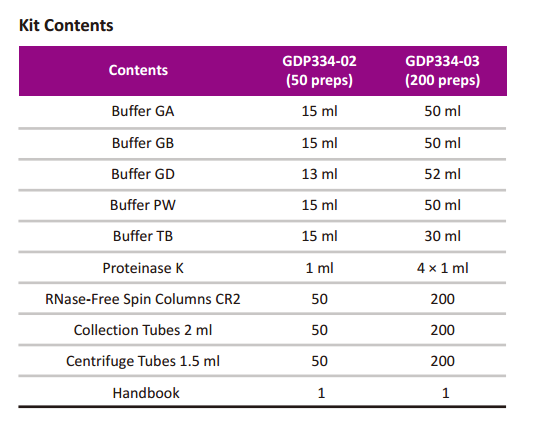GDP334-TIANamp Blood Spots DNA Kit
TIANamp Blood Spots DNA Kit
Extraction of genomic DNA from dried
blood spots samples
TIANamp Blood Spots DNA Kit
Cat.no. GDP334
(Spin Column)

Storage
This kit can be store at room temperature (15-30°C) for 15 months. If any
precipitate forms in the buffers, it should be dissolved by warming the
buffers at 37°C before use
Introduction
The kit adopts a centrifugal adsorption column capable of specifically
binding DNA and a unique buffer system to extract genomic DNA in dried
blood spots. The silica matrix material used in the centrifugal adsorption
column is a unique new material of TIANGEN, which can adsorb DNA
efficiently and specifically, and can remove impurity proteins and other
organic compounds in cells to the greatest extent. The extracted genomic
DNA has large fragments, high purity and stable and reliable quality.
The DNA purified by the kit is suitable for various conventional operations,
including enzyme digestion, PCR, fluorescence quantitative PCR, library
construction, Southern blot, etc.
Sample Collection, Storage and Transportation
- Sampling: Collect the sample according to the method of collecting
dried blood spots with filter paper. - Sample storage: The sample collected above can be immediately
used for processing, or stored under the conditions of sealing, drying
(humidity lower than 30%) and 2 ~8°C for 5 years. When transporting
samples, filter paper dried blood spots should be sealed and transported
with foam box filled with ice.
Important Notes Please read these notes before using this kit.
- If there is precipitation in Buffer GA or GB, it can be redissolved in a
37°C water bath and used after shaking to mix thoroughly. - After using the solution, tighten the bottle cap to avoid evaporation.
- Perform all centrifugation steps at room temperature.
- If the solution comes into contact with skin and mucous membrane,
please immediately flush it with tap water. It will not cause harm to the
operator.
Protocol
Before use, please add ethanol (96-100%) to Buffer GD and Buffer PW
according to the instruction on the bottle label.
- Take three 3 × 3 mm dried blood spot samples into a 1.5 ml centrifuge
tube (self-provided). - Add 200 µl of Buffer GA to the tube.
- Add 20 µl Proteinase K, vortex for 10 sec to mix well, then put it into a
thermostatic shaker preheated to 56°C and shake at 900 rpm for 1 h. - Centrifuge briefly, add 200 µl of Buffer GB, vortex for 10 sec to mix well.
Place the centrifuge tube into a thermostatic shaker preheated to 70°C
and shake at 900 rpm for 10 min. After the incubation, centrifuge briefly
to remove the droplets on the inner wall of the tube cover.
Note: White precipitate may be generated when adding Buffer GB,
which will disappear when it is placed at 70°C without affecting
subsequent experiments. If the solution is not clear, it indicates that
the cell lysis is not complete, which may lead to low DNA yield and
purity. - Add 100 µl of ethanol (96-100%) to the tube. If the room temperature
exceeds 25°C, precool the ethanol on ice. Gently invert to mix the
sample, place it at room temperature for 5 min, and centrifuge briefly to
remove the droplets on the inner wall of the tube cover. - Add the solution obtained in the previous step to a RNase-Free Spin
Columns CR2 (place CR2 in a collection tube), centrifuge at 12,000 rpm (~
13,400 × g) for 30 sec, discard the waste liquid from the collection tube,
and put back the RNase-Free Spin Columns CR2 into the collection tube. - Add 500 µl Buffer GD to RNase-Free Spin Columns CR2 (ensure that
ethanol has been added before use), centrifuge at 12,000 rpm (~
13,400 × g) for 30 sec, discard waste liquid from the collection tube, and
return RNase-Free Spin Columns CR2 to the collection tube. - Add 700 µl of Buffer PW to the RNase-Free Spin Columns CR2 (ensure
that ethanol has been added before use), centrifuge at 12,000 rpm (~
13,400 × g) for 30 sec, discard the waste liquid from the collection tube,
and return the RNase-Free Spin Columns CR2 to the collection tube. - Add 500 µl of Buffer PW to RNase-Free Spin Columns CR2 and centrifuge
at 12,000 rpm (~ 13,400 × g) for 30 sec. Discard the waste liquid from
the collection tube. - Put the RNase-Free Spin Columns CR2 back into the waste liquid
collection tube, centrifuge at 12,000 rpm (~13,400 × g) for 2 min, and
discard the waste liquid. Place the RNase-Free Spin Columns CR2 at
room temperature for 2-5 min to completely dry the residual buffer in
the adsorption membrane.
Note: The purpose of this step is to remove the residual buffer in the
adsorption column. The residual ethanol in the buffer will affect the
subsequent enzyme reaction (enzyme digestion, PCR, etc.). - Transfer the RNase-Free Spin Columns CR2 into a clean centrifuge tube,
pipette 20-50 µl of Buffer TB in the middle of the adsorption membrane,
place at room temperature for 2-5 min, centrifuge at 12,000 rpm (~
13,400 × g) for 2 min, and collect the solution into the centrifuge tube.
Note: The volume of the buffer should not be less than 20 μl. Too small
a volume will affect the recovery efficiency. In order to increase the
yield of genomic DNA, the DNA solution obtained by centrifugation
can be added to adsorption column CR2 again, and placed at room
temperature for 2 min, and centrifuged at 12,000 rpm(~13,400 × g)
for 2 min. The pH value of the elute buffer has a great influence on
the elution efficiency. If water is used as eluent, the pH value should
be ensured to be within the range of 7.0-8.5 (the pH value of water
can be adjusted to this range by NaOH), and the pH value lower than
7.0 will reduce the elution efficiency. DNA products should be kept at
-20°C to prevent DNA degradation.
GDP334-TIANamp Blood Spots DNA Kit
All trademarks or registered trademarks appearing on this website are the property of their respective owners.
This product is for scientific research use only. Do not use in medicine, clinical treatment, food or cosmetics.
Need more info ? Contact us anytime. We’re here: Go2biotech
E-mail: maggie@go2biotech.com / morgan@go2biotech.com
Telephone:+86 755 8399 5017


